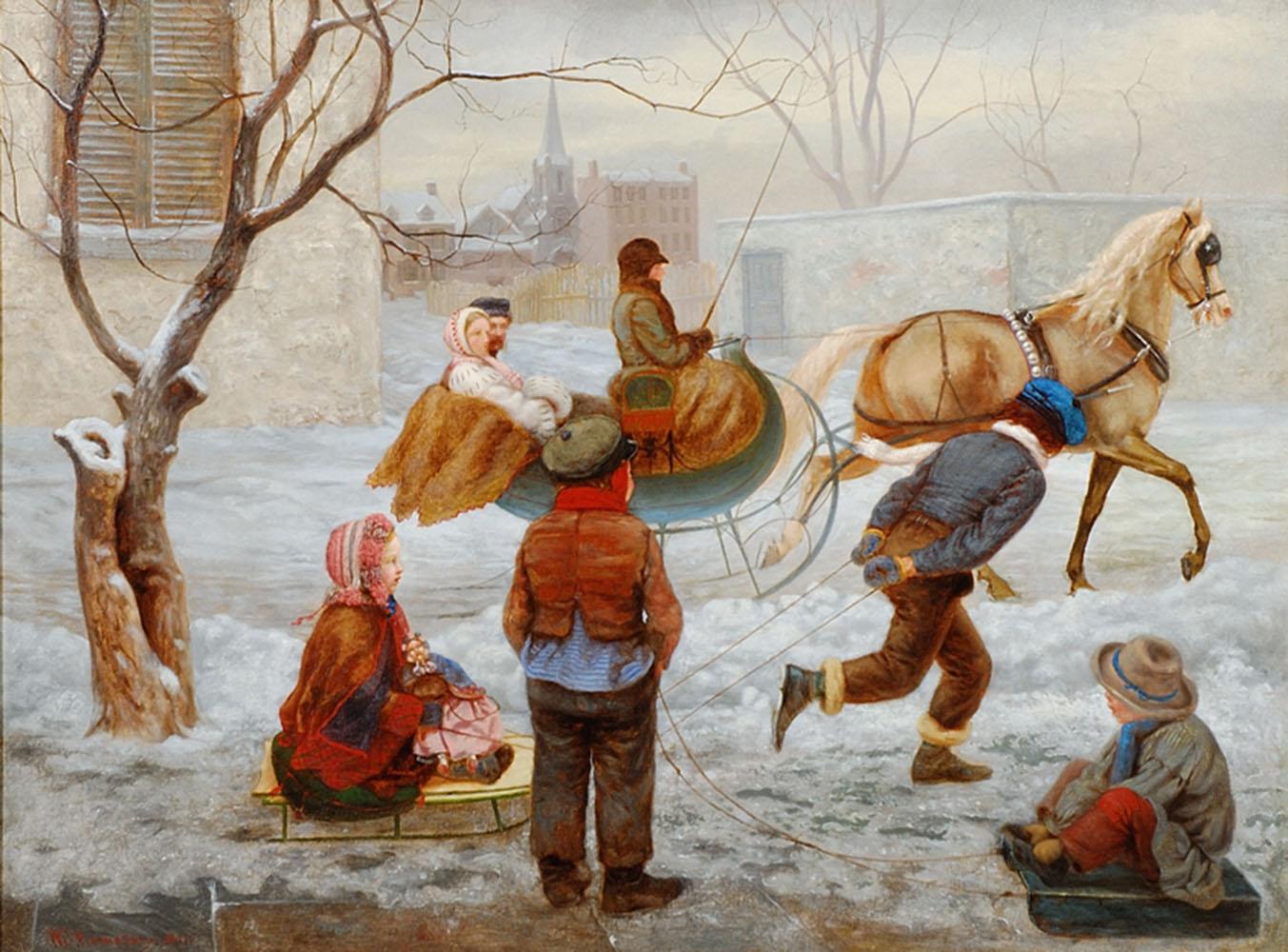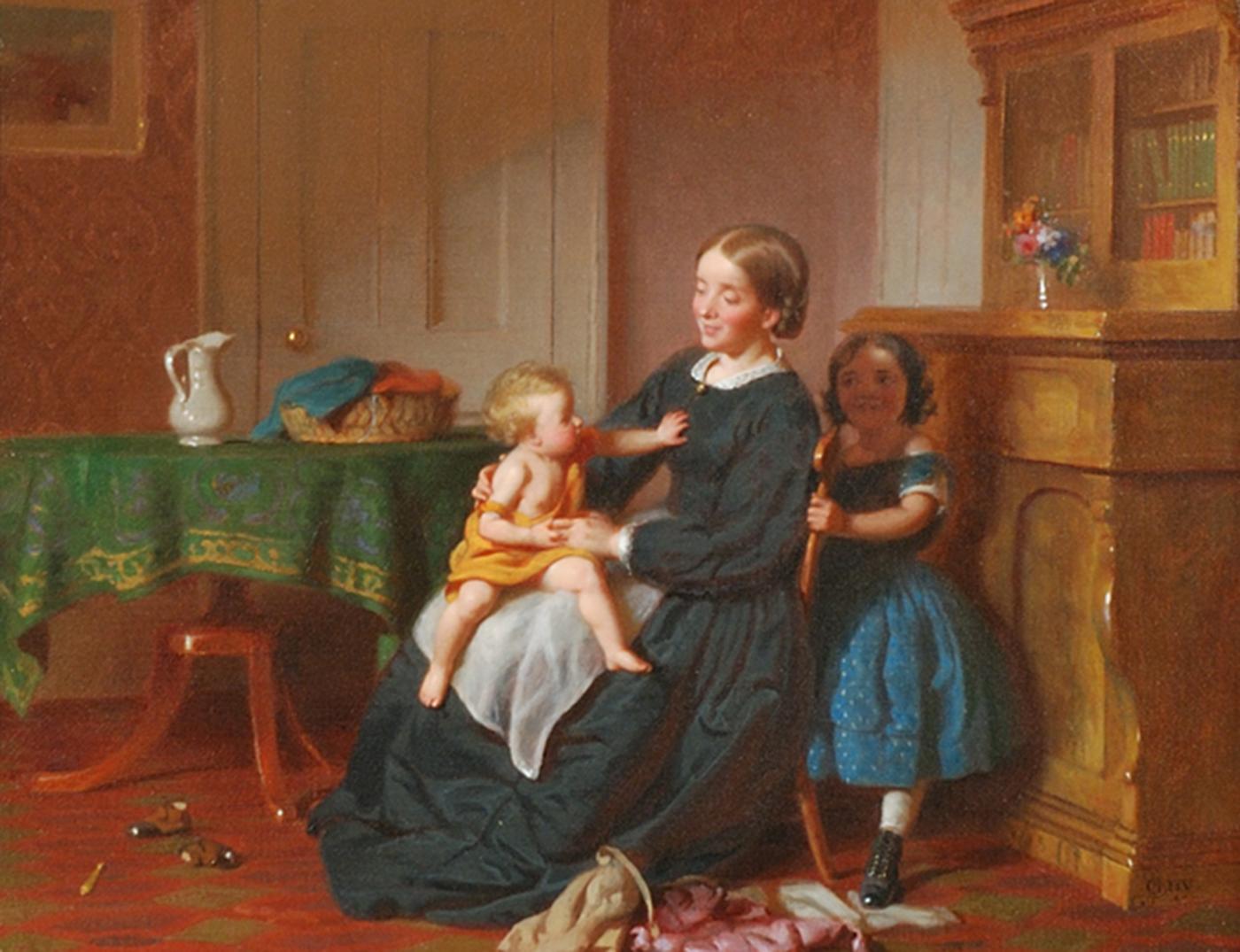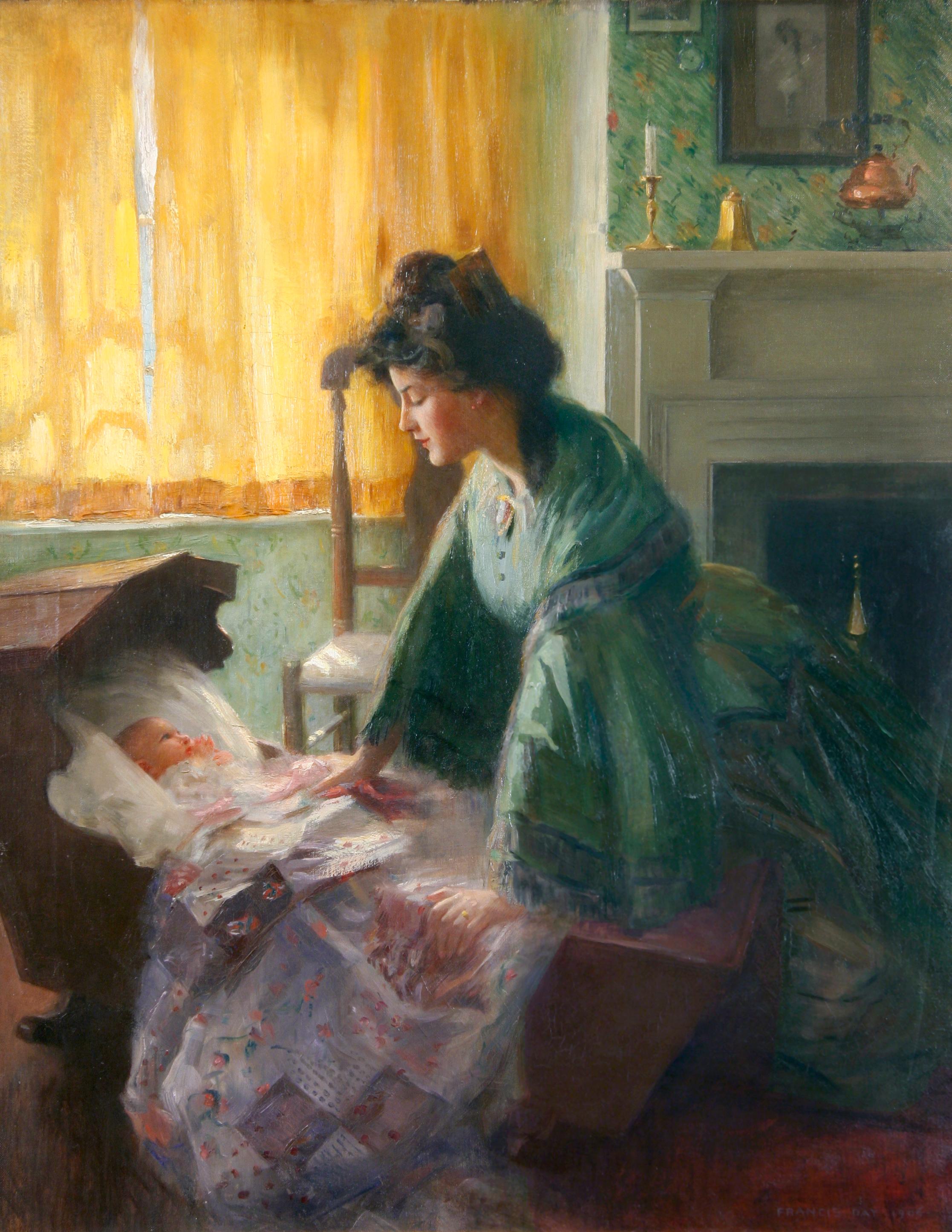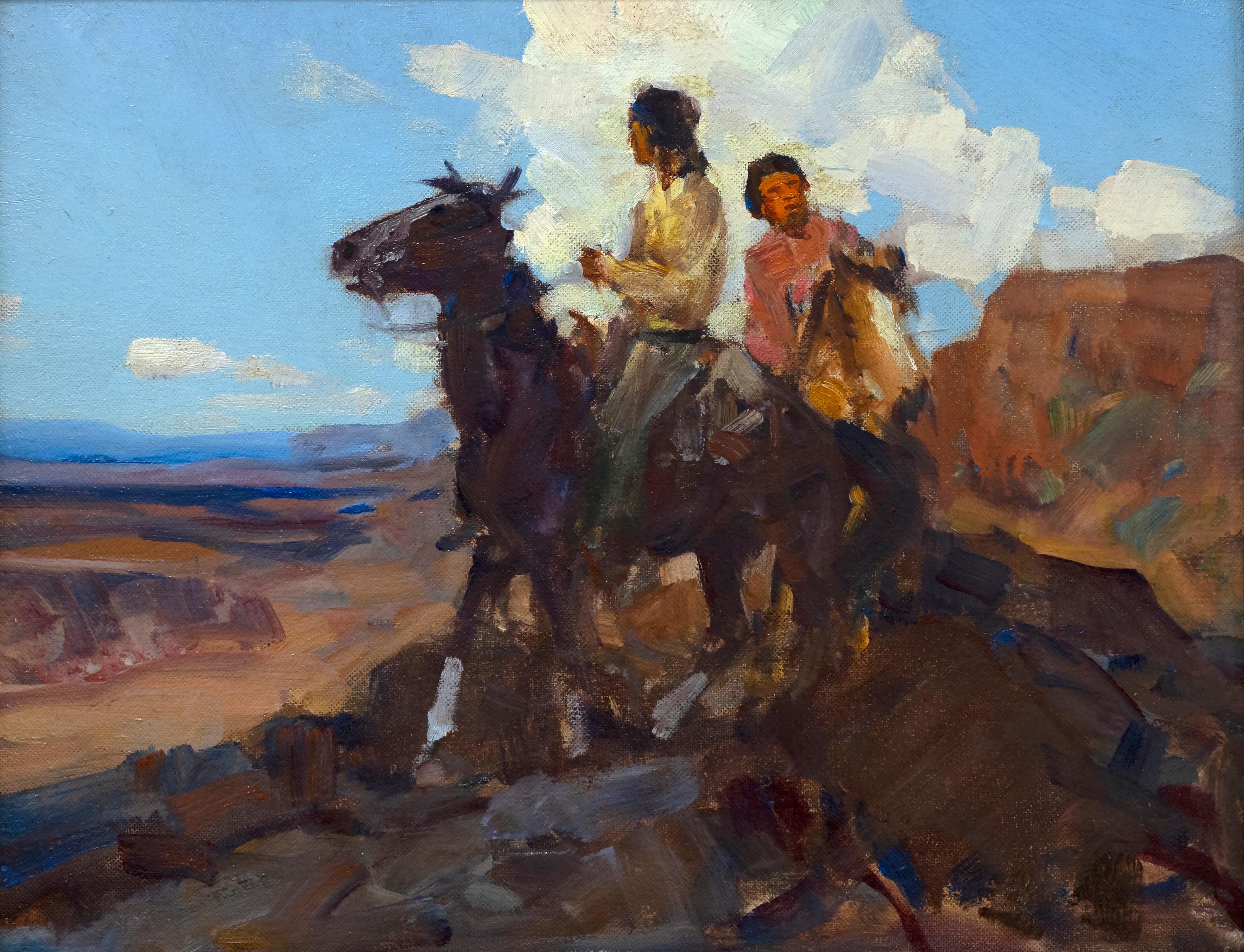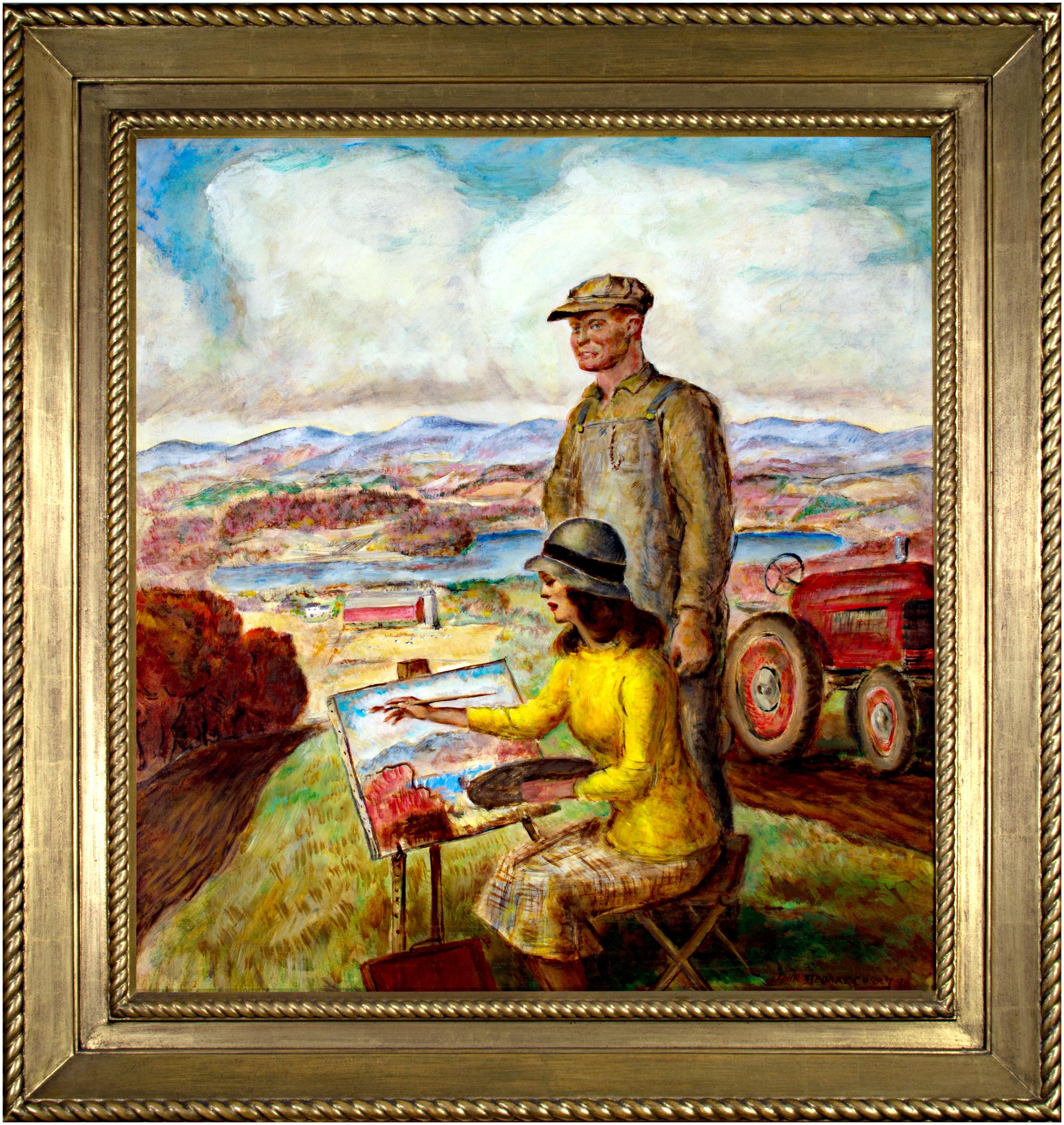Items Similar to Summer. "Hush"
Want more images or videos?
Request additional images or videos from the seller
1 of 12
Newell Convers WyethSummer. "Hush"1909
1909
About the Item
"Summer. "Hush"" is a painting by American artist N.C. Wyeth. It is an oil on canvas work and is signed lower right, “NC WYETH” and inscribed lower left, “Inscribed to Clara and Edwin on their wedding day Dec 25, 1913”.
Provenance:
Mr. and Mrs. Edwin R. Wyeth, 1913
Mrs. Edwin Wyeth, to 1988
(Judy Goffman Fine Art, New York, NY, May 1991)
Collection of John Edward Dell, to August 1995
Private collection, New York, to 2008
[Somerville Manning Gallery, Greenville, Deleware, April 2008]
Exhibition:
Philadelphia, PA, 1910, no. 798 on p. 51, as "Summer"
Chadds Ford, PA, 1972, no. 12; Greenville, DE, 1995
Greenville, DE, Somerville Manning Gallery, "N. C. Wyeth: Painter and Illustrator," June 14-Sept. 14, 2019
Literature:
Betsy James Wyeth, ed., The Wyeths, The Letters of N. C. Wyeth, 1901-1945 (Boston: Gambit, 1971), ps. 312, 313
Douglas Allen and Douglas Allen, Jr., N. C. Wyeth, The Collected Paintings, Illustrations and Murals (New York: Crown Publishers, 1972), p. 275, illustration in b/w p. 62
John Edward Dell, ed., Visions of Adventure, N. C. Wyeth and the Brandywine Artists (New York: Watson-Guptill Publications, 2000), illustration in color p. 64
Christine B. Podmaniczky, N. C. Wyeth, A Catalogue Raisonné of Paintings (London: Scala, 2008), I.284, p. 200
Emerging at the end of the Gilded Age, N.C. Wyeth was one of the most important American artists and illustrators. His paintings and illustrations brought life to classic literature from Treasure Island to The Boy’s King Arthur and more. He is most remembered for his ability to capture crucial moments in narratives, fleshing out just a few words into a visual representation of deep drama and tension. Patriarch of the Wyeth artistic dynasty which includes his son Andrew and grandson Jamie, his influence touched future illustrators and artists.
Perhaps his most important legacy is how he shaped American imagination – of America itself and of wild possibilities. Wyeth’s powerful paintings gave life to many of the stories America told of itself. His early paintings captured life of the American West and some of his most beloved illustrations were for novels such as The Last of the Mohicans or short stories like “Rip Van Winkle”. Despite this success, Wyeth struggled with the commercialism of illustrations and advertisements, seeking his work to be accepted as fine art. Throughout his career, he experimented with different styles shifting from Impressionism to Divisionism to Regionalism.
N.C. Wyeth produced over 3,000 paintings and illustrated 112 books. His illustrations for the publisher Charles Scribner’s Sons were so popular they became known as Scribner’s Classics and remain in print to this day.
This quietly powerful painting of a Native American forms part of a quartet of paintings, inspired by and a metaphor for the four seasons. The paintings were used to illustrate George T. Marsh’s set of poems “The Moods”. Wyeth recognized that the series came at a crucial moment in his career in which the paintings go beyond realism to capture atmosphere and mood, an internal world of emotion made external. He even contemplated and attempted to write his own poems based on these paintings.
Summer, Hush is a striking example of Wyeth pulling from his imagination and melding it with careful observation of nature. As noted in a letter to his mother, Wyeth combined the fictional subject with natural effects as in the sky. Native Americans were a subject he returned to numerous times; these paintings reflect not only Wyeth’s fascination but also of America. As observed by art historian Krstine Ronan, Wyeth was part of a larger dialogue that developed around Native Americans, cementing a general Native American culture in the imagination of the United States. Thus, the painting operates on numerous levels simultaneously. How do we relate to this painting and its conception of the four seasons? How do we interpret Wyeth’s depiction of a Native American? What role do Native American’s play in America’s imagination?
We must also not forget that these works were first used to illustrate the poems of George T. Marsh. Marsh, a poet born in New York that often also wrote of the Canadian wilderness, provides subtle evocations of the seasons hinted at in the series title “The Moods”. This painting was used alongside “Hush” which ends:
Are they runes of summers perished
That the fisher hears –and ceases—
Or the voice of one he cherished.
Within these few lines, Wyeth gives us a thoughtful and restrained painting that stirs from within. The poem and the painting avoid obvious clichés to represent the seasons. They develop a profound interpretation filled with sensitivity.
These paintings were important to Wyeth who hoped that “they may suggest to some architect the idea that such decorations would be appropriate in a library or capitol or some public building.” Summer, Hush demonstrates Wyeth’s control of color and composition so that small touches such as the ripples of water or the towering cloud that envelopes the figure are in service to sketch out the feeling of summer and of the poem. Through exploring this rich and complex painting we are better able to appreciate NC Wyeth as an artist and the role in which his work both in general and this specific painting plays in the context of art history.
- Creator:Newell Convers Wyeth (1882-1945, American)
- Creation Year:1909
- Dimensions:Height: 33.75 in (85.73 cm)Width: 30.25 in (76.84 cm)
- Medium:
- Movement & Style:
- Period:
- Condition:
- Gallery Location:Palm Desert, CA
- Reference Number:
About the Seller
4.8
Recognized Seller
These prestigious sellers are industry leaders and represent the highest echelon for item quality and design.
Established in 1996
1stDibs seller since 2011
101 sales on 1stDibs
Typical response time: 6 hours
- ShippingRetrieving quote...Ships From: Jackson, WY
- Return PolicyA return for this item may be initiated within 7 days of delivery.
More From This SellerView All
- ScoutingBy Frank Tenney JohnsonLocated in Palm Desert, CA"Scouting" is an oil on canvas painting by Frank Tenney Johnson. The framed piece measures 23 3/4 x 27 3/4 x 3 1/4 inches. Johnson was well-known for his work of the American west, particularly for his portrayal of cowboys at night, lit by moonlight. Johnson utilized knives and fingers when painting, so his work is recognizable for its distinctive marks. Provenance: Biltmore Galleries, Scottsdale...Category
Early 20th Century American Realist Landscape Paintings
MaterialsCanvas, Oil
- Puritan Cod FishersLocated in Palm Desert, CAA painting by father and son N.C. Wyeth and Andrew Wyeth. "Puritan Cod Fishers" is a 20th century painting from N.C. Wyeth's commission of murals for the Metropolitan Life Insurance...Category
20th Century American Realist Figurative Paintings
MaterialsOil, Canvas
- The Young ArtistBy Grant WoodLocated in Palm Desert, CA"The Young Artist" is an oil on panel painting made in 1926 by Grant Wood. The work is signed lower right, "Grant Wood". The painting size is 11 x 14 x 1 inches. The framed size is 2...Category
Early 20th Century American Realist Landscape Paintings
MaterialsOil, Panel
- Navajo CampBy Gerard Curtis DelanoLocated in Palm Desert, CA"Navajo Camp" is an oil on panel painting by Gerard Curtis Delano. The painting is signed lower left "Delano". The framed piece measures 31 x 36 3/4 x 1 7/8 inches. Delano was a pai...Category
Early 20th Century American Realist Landscape Paintings
MaterialsPanel, Oil
- UntitledBy Nathan OliveiraLocated in Palm Desert, CAA painting by Nathan Oliveira. "Untitled" is a Bay Area Figurative Painting, oil on canvas in a brown and tan palette by American artist Nathan Oliveira. The artwork is signed in the...Category
Late 20th Century Post-War Figurative Paintings
MaterialsCanvas, Oil
- MaskBy Nathan OliveiraLocated in Palm Desert, CAA painting by Nathan Oliveira. "Mask" is a Post-War painting, acrylic, earth, and oil on canvas by Bay Area Figurative artist Nathan Oliveira. The artwork is signed and dated in the ...Category
Late 20th Century Post-War Abstract Paintings
MaterialsCanvas, Mixed Media, Oil, Acrylic
You May Also Like
- The RaceBy William John HennessyLocated in New York, NYWilliam John Hennessy was born in Ireland. He came to America in 1849 with his mother and brother a year after his father had fled their homeland after taking part in the unsuccessful Young Ireland Party uprising. The Hennessys settled in New York, and when young William came of age, he decided upon a career as an artist. At the age of fifteen, he enrolled at the National Academy of Design, where he learned to draw from the antique, and the following year he was granted admission to the Academy’s life-drawing class. Hennessy first exhibited at the National Academy in 1857, starting a continuous run of appearances in their annuals that lasted until 1870, when he expatriated himself to Europe. During his time in America, Hennessy was principally known as a genre painter and prolific illustrator for such publications as Harper’s Weekly and a number of books, including illustrated works of William Cullen Bryant...Category
19th Century American Realist Figurative Paintings
MaterialsCanvas, Oil
- Peek-a-BooBy Seymour Joseph GuyLocated in New York, NYIn the latter half of the nineteenth century and into the first decade of the twentieth, New York City art aficionados could count on finding recent work of Seymour Joseph Guy hanging on the walls of the city’s major galleries. Primarily a genre artist, but also a portraitist, between 1859 and 1908 Guy showed more than seventy works at the National Academy of Design. From 1871 to 1903 he contributed over seventy times to exhibitions at the Century Club. From 1864 to 1887, he sent about forty pictures to the Brooklyn Art Association. A good number of these works were already privately owned; they served as advertisements for other pictures that were available for sale. Some pictures were shown multiple times in the same or different venues. Guy was as easy to find as his canvases were omnipresent. Though he lived at first in Brooklyn with his family and then in New Jersey, from 1863 to his death in 1910 he maintained a studio at the Artist’s Studio Building at 55 West 10th Street, a location that was, for much of that period, the center of the New York City art world. Guy’s path to a successful career as an artist was by no means smooth or even likely. Born in Greenwich, England, he was orphaned at the age of nine. His early interest in art was discouraged by his legal guardian, who wanted a more settled trade for the young man. Only after the guardian also died was Guy free to pursue his intention of becoming an artist. The details of Guy’s early training in art are unclear. His first teacher is believed to have been Thomas Buttersworth...Category
19th Century American Realist Figurative Paintings
MaterialsCanvas, Oil
- Light of LoveLocated in Washington, DCExhibited: National Academy of Design, New York, 1906 (as no. 101) Art Institute of Chicago, 1908 (as no. 74)Category
Early 1900s American Realist Figurative Paintings
MaterialsCanvas, Oil
- 'Sketching Wisconsin' original oil painting, SignedBy John Steuart CurryLocated in Milwaukee, WIJohn Steuart Curry "Sketching Wisconsin," 1946 oil on canvas 31.13 x 28 inches, canvas 39.75 x 36.75 x 2.5 inches, frame Signed and dated lower right Overall excellent condition Presented in a 24-karat gold leaf hand-carved wood frame John Steuart Curry (1897-1946) was an American regionalist painter active during the Great Depression and into World War II. He was born in Kansas on his family’s farm but went on to study art in Chicago, Paris and New York as young man. In Paris, he was exposed to the work of masters such as Peter Paul Rubens, Eugène Delacroix and Jacques-Louis David. As he matured, his work showed the influence of these masters, especially in his compositional decisions. Like the two other Midwestern regionalist artists that are most often grouped with him, Grant Wood (American, 1891-1942) and Thomas Hart Benton (American, 1889-1975), Curry was interested in representational works containing distinctly American subject matter. This was contrary to the popular art at the time, which was moving closer and closer to abstraction and individual expression. Sketching Wisconsin is an oil painting completed in 1946, the last year of John Steuart Curry’s life, during which time he was the artist-in-residence at the University of Wisconsin in Madison. The painting is significant in Curry’s body of work both as a very revealing self-portrait, and as a landscape that clearly and sensitively depicts the scenery of southern Wisconsin near Madison. It is also a portrait of the artist’s second wife, Kathleen Gould Curry, and is unique in that it contains a ‘picture within a picture,’ a compositional element that many early painting masters used to draw the eye of the viewer. This particular artwork adds a new twist to this theme: Curry’s wife is creating essentially the same painting the viewer is looking at when viewing Sketching Wisconsin. The triangular composition of the figures in the foreground immediately brings focus to a younger Curry, whose head penetrates the horizon line and whose gaze looks out towards the viewer. The eye then moves down to Mrs. Curry, who, seated on a folding stool and with her hand raised to paint the canvas on the easel before her, anchors the triangular composition. The shape is repeated in the legs of the stool and the easel. Behind the two figures, stripes of furrowed fields fall away gently down the hillside to a farmstead and small lake below. Beyond the lake, patches of field and forest rise and fall into the distance, and eventually give way to blue hills. Here, Curry has subverted the traditional artist’s self-portrait by portraying himself as a farmer first and an artist second. He rejects what he sees as an elitist art world of the East Coast and Europe. In this self-portrait he depicts himself without any pretense or the instruments of his profession and with a red tractor standing in the field behind him as if he was taking a break from the field work. Here, Curry’s wife symbolizes John Steuart Curry’s identity as an artist. Compared with a self-portrait of the artist completed a decade earlier, this work shows a marked departure from how the artist previously presented and viewed himself. In the earlier portrait, Curry depicted himself in the studio with brushes in hand, and with some of his more recognizable and successful canvases behind him. But in Sketching Wisconsin, Curry has taken himself out of the studio and into the field, indicating a shift in the artist’s self-conception. Sketching Wisconsin’s rural subject also expresses Curry’s populist ideals, that art could be relevant to anyone. This followed the broad educational objectives of UW’s artist-in-residence program. Curry was appointed to his position at the University of Wisconsin in 1937 and was the first person to hold any such position in the country, the purpose of which was to serve as an educational resource to the people of the state. He embraced his role at the University with zeal and not only opened the doors of his campus studio in the School of Agriculture to the community, but also spent a great deal of time traveling around the state of Wisconsin to visit rural artists who could benefit from his expertise. It was during his ten years in the program that Curry was able to put into practice his belief that art should be meaningful to the rural populace. However, during this time he also struggled with public criticism, as the dominant forces of the art market were moving away from representation. Perhaps it was Curry’s desire for public acceptance during the latter part of his career that caused him to portray himself as an Everyman in Sketching Wisconsin. Beyond its importance as a portrait of the artist, Sketching Wisconsin is also a detailed and sensitive landscape that shows us Curry’s deep personal connection to his environment. The landscape here can be compared to Wisconsin Landscape of 1938-39 (the Metropolitan Museum of Art), which presents a similar tableau of rolling hills with a patchwork of fields. Like Wisconsin Landscape, this is an incredibly detailed and expressive depiction of a place close to the artist’s heart. This expressive landscape is certainly the result of many hours spent sketching people, animals, weather conditions and topography of Wisconsin as Curry traveled around the state. The backdrop of undulating hills and the sweeping horizon, and the emotions evoked by it, are emphatically recognizable as the ‘driftless’ area of south-central Wisconsin. But while the Metropolitan’s Wisconsin Landscape conveys a sense of uncertainty or foreboding with its dramatic spring cloudscape and alternating bands of light and dark, Sketching Wisconsin has a warm and reflective mood. The colors of the foliage indicate that it is late summer and Curry seems to look out at the viewer approvingly, as if satisfied with the fertile ground surrounding him. The landscape in Sketching Wisconsin is also revealing of what became one of Curry’s passions while artist-in-residence at UW’s School of Agriculture – soil conservation. When Curry was a child in Kansas, he saw his father almost lose his farm and its soil to the erosion of The Dust Bowl. Therefore, he was very enthusiastic about ideas from UW’s School of Agriculture on soil conservation methods being used on Wisconsin farms. In Sketching Wisconsin, we see evidence of crop rotation methods in the terraced stripes of fields leading down the hillside away from the Curry’s and in how they alternate between cultivated and fallow fields. Overall, Sketching Wisconsin has a warm, reflective, and comfortably pastoral atmosphere, and the perceived shift in Curry’s self-image that is evident in the portrait is a positive one. After his rise to favor in the art world in the 1930’s, and then rejection from it due to the strong beliefs presented in his art, Curry is satisfied and proud to be farmer in this self-portrait. Curry suffered from high blood...Category
1940s American Realist Figurative Paintings
MaterialsOil, Canvas
- Antique American Oil Painting Portrait Young Woman Necklace Period Frame RareLocated in Buffalo, NYA beautiful and rare antique American portrait of a young woman in a stunning period frame, likely original to the piece. Unsigned but beaut...Category
1890s American Realist Portrait Paintings
MaterialsOil, Canvas
- VictoryLocated in Ibadan, Oyo"Victory" emanates a sense of vibrancy and vitality, drawing viewers into its world of anticipation and celebration. The central figure, depicted with a wide grin and laughter lines ...Category
21st Century and Contemporary American Realist Mixed Media
MaterialsCanvas, Mixed Media, Oil, Acrylic
